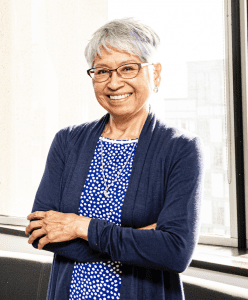 During the month of November we recognize Native American Heritage Month by introducing you to a group of innovators and leaders who move us forward on a path to a better, more inclusive, and more just future. We hope you enjoy learning about their programs built to help Native students thrive in college and beyond.
During the month of November we recognize Native American Heritage Month by introducing you to a group of innovators and leaders who move us forward on a path to a better, more inclusive, and more just future. We hope you enjoy learning about their programs built to help Native students thrive in college and beyond.
Nya weñha skanñoh. I greet you in peace and good intentions from the shared territory of the Huron-Wendat and Petun First Nations, the Seneca, and the Mississaugas of the Credit River. I’m an associate professor in the Leadership, Adult, & Higher Education department at the Ontario Institute for Studies in Education (OISE) at the University of Toronto. I coordinate the Student Development/Student Services program stream. Student affairs, as an academic discipline, is fairly new in Canada so it’s an exciting time to be here.
OISE has seven Indigenous faculty, four of whom are Haudenosaunee! Some programs here are the Indigenous Mental Health and Social Policy program and the Indigenous Education Network (IEN). The IEN has an office suite and staff, including an Elder-in-residence who conducts traditional teachings and has drop-in hours for one-on-one consultation. The Deepening Knowledge Project “seeks to infuse Indigenous peoples’ histories, knowledges and pedagogies into all levels of education in Canada” (OISE website). The OISE library has a librarian who specializes in Indigenous education and studies. These are just some of the resources at OISE. The University of Toronto also has staff, faculty, and services for Indigenous students including First Nations House.
My goal is to enhance student services and knowledge about Indigenous people and our communities so that students can thrive in postsecondary rather than having to endure educational structures that deny their Indigeneity. Key elements that Indigenous students need are role models and faculty and staff who understand them; the ability to remain close to community and family; access to services like study skills and financial aid office personnel who are familiar with Indigenous communities; a place to be like an Indigenous Student Center (ISC) or House; and “familiar faces.” Role models and student centers play key roles in student success. Many college graduates have shared with me that their secondary schools and school counselors were not supportive. This means community members are important partners in postsecondary access and that institutions need to recruit in our communities.
I feel strongly that institutions must commit to working with Indigenous communities, Indigenous faculty, staff, and students. I am currently researching how institutions support Indigenous students particularly through ISCs to learn how to better sustain these units and support our students and communities in respectful ways. The ISC cannot be everything for every student; for one, there may be only one ISC staff person, perhaps five at the most, and they must rely on other units to support our students. Non-Indigenous staff are typically not educated about Indigenous communities or students and this can cause problems. ISC often have to advocate and educate the faculty and staff in these other units. Educating non-ISC staff should not fall on solely ISC staff and Indigenous faculty. Please check out the resources like those mentioned below in addition to books written by Indigenous scholars.
Stephanie J. Waterman, PhD (she/her/hers), Onondaga, Turtle Clan is an associate professor at the Ontario Institute for Studies in Education at the University of Toronto. She coordinates the Student Development/Student Services stream.
Recommended reading:
Shotton, Lowe & Waterman, (Eds.) (2013). Beyond the asterisk: Understanding Native students in higher education. Sterling, VA: Stylus.
Minthorn & Chavez (Eds.). (2015). Indigenous leadership in higher education. Routledge.
Waterman, Lowe & Shotton (Eds). (2018). Beyond access: Indigenizing programs for Native American student success. Sterling, VA: Stylus
